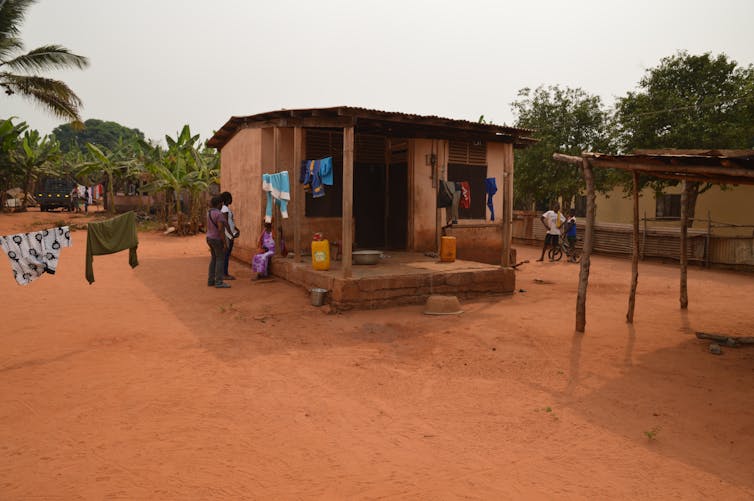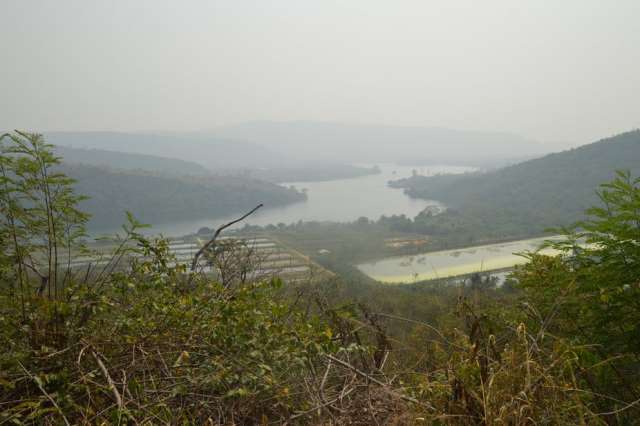Iain Jackson, University of Liverpool
The Volta River project in Ghana was a symbolic embodiment of progress, modernisation, and development.
It offered the opportunity for newly independent Ghana to develop a complex and integrated industrial base using local resources and materials.
While the initial concept was discussed as early as 1924, it was only in the 1950s that the feasibility report was written and work commenced.
The idea was to harness power generated from a hydroelectric dam to smelt bauxite into aluminium and to export it from the newly built port-town of Tema. For Kwame Nkrumah, Ghana’s first post independence leader, it was a perfect blend of nationalist development and international trade. It was a means of throwing off the shame of an imperial past with an ambitious and prestigious infrastructure project.
The development was not only concerned with industry, Nkrumah was also adamant that housing provision was to be enhanced. The aluminium plant workers were to be housed in a purpose built new town at Kpong with an array of social amenities, parks, health and education facilities.
The problem, like with most idealistic visions, was funding the venture. Nkrumah had secured some, if limited, backing from the UK government, and was hoping for the UK-Canadian aluminium venture to provide the remainder.
Nkrumah’s commitment to high quality housing for the smelter workers was admirable – but the business consortium didn’t share this generous vision and was reluctant to fund even the most basic dwellings. The idea of providing extensive sports facilities and high quality infrastructure was an anathema. The negotiations eventually failed.
But the project was too important to Nkrumah and he persisted in seeking new partners, including Soviet support, which deeply concerned the UK and US. Eventually, US steel magnate and dam builder Henry J. Kaiser agreed to deliver the project. The deal involved moving the smelter closer to the new town of Tema, and using imported US bauxite. This destroyed Nkrumah’s aspirations to use local raw materials.
Nevertheless, a new town called Akosombo was built to house the hydro-power station workers at the dam site. To this day it has a carefully controlled town plan and highly accountable local government to ensure that the main town is properly managed, complete with maintained markets, roads and facilities.
The hydro-electric dam is still rightly a source of immense national pride, and the prestige of the project is reflected in the township. It is like no other town in Ghana, and its manicured landscapes, housing and commitment to being a well run town renders it a highly attractive place to live among the beautiful hills and within close proximity to Accra.
But not everything worked out this well. A town called New Ajena was also developed to house communities that were forced to move because of the dam. This was a much less successful project.
Useful lessons can be learnt from both. In our recently published paper we assessed the development of the high profile project from the perspective of providing housing. Housing was indeed provided, but not uniformly. In addition, extensive social provision was seen as a luxury item and quickly cut from budgets by the early 1960s. As a result housing for the most vulnerable was only deemed possible if it included a “self-build” contribution by the residents themselves.
The failures
The dam resulted in the formation of one of the world’s largest man-made lakes. 80,000 people living upstream were forced to flee their fertile farms and ancestral lands as the water level continued to rise and flooded their homes.
Nkrumah decreed that “no one would be made worse off” and a programme of replacement homes and villages commenced. But there was substantial delay.
The World Food Programme was forced to intervene. It didn’t simply hand out supplies, but instead distributed food in exchange for labour. Residents were forced to “clear” 450,000 acres (182,109 hectares) to make way for the first 18 resettlement sites. 739 villages were eventually consolidated into 52 townships to benefit from economies of scale for services, school provision, road maintenance and market stalls.
New Ajena was one of the first resettlement villages to replace the former Ajena now submerged by the lake. Sites were selected based on being easily accessible, close to good farming areas, and ideally at high altitude with a good water supply. This did not leave many options and most new settlements, like New Ajena, were simply placed at the lake edge. The housing stock loosely tracks the road and is arranged in informal clusters.

Iain Jackson, CC BY-NC-SA
The use of standard components and basic construction resulted in rapid production rates with over 200 houses built a week, and 11,000 units completed by 1964. The housing type was called a “core house” – effectively a single room and raised veranda. The idea was for the residents to gradually extend the houses as required, according to a prescribed plan and building standard.
As part of my research I spoke to some residents who have lived in the settlement since the early 1960s. They can remember the developments that have taken place. They can recall some larger families being forced to move from substantial multi-room structures to one simple room which resulted in overcrowded and unsanitary conditions.
Extensions and modifications to the core houses have been limited, although most have added an extra room and extended the front porch. Water is still obtained via a stand-pipe which serves as the local gathering place. There are shared latrines (which are generally unpopular) although many residents have constructed their own bathhouses.
Undelivered promises
The promise of material modernisation has still not been delivered. A small primary school was built along with the core houses and more recently a secondary school has been constructed by the residents. A shop provides basic supplies and most residents keep goats and chickens and grow fruit and vegetables. The settlement has been criticised for its unauthorised structures and land use, but without this cultivation, such a remote town could not have survived.
While the development has not quite adhered to the plan and early proposals inflicted hardship on many, it is now very much a thriving settlement. Basic social amenities are slowly being added as the village sees fit.
Formal planning and the precise placing of buildings, overly prescriptive building regulations and rule-making have yielded to a schematic set of principles that devolve far greater control to residents and they should be commended for their efforts.
Lessons learned
The Akosombo plan is a pristine example of top-down planning with a highly controlled environment. But it only managed to house a small and privileged portion of society. If this model can be funded and delivered to a large community it is certainly a valid and attractive option.
Where this is not possible, New Ajena offers another route, one that is more inclusive and reliant on the goodwill and hard work of the community, but one that shows how large populations can be rehoused quickly.
Of course, it need not be a case of one or the other, and the planned Akosombo model, with associated satellite self-built villages, could deliver a sustainable and affordable solution to housing in Ghana.![]()
Iain Jackson, Professor and Architect, University of Liverpool
This article is republished from The Conversation under a Creative Commons license. Read the original article.
Read Also
How Africa’s housing crisis can be tackled

